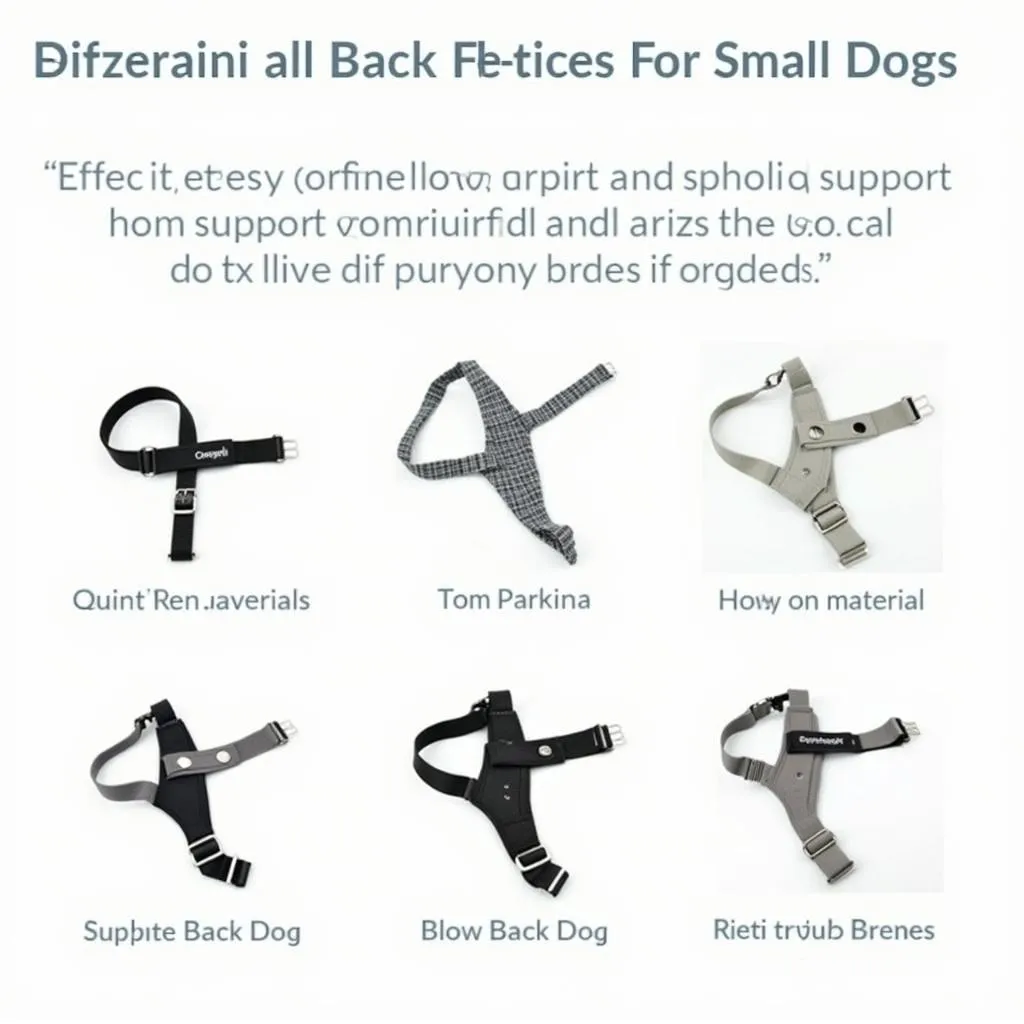“Con chó nhỏ, nhưng lòng son sắt” – a common saying in Vietnam that perfectly encapsulates the love we have for our furry companions. But like all creatures, even our small dogs can experience back pain and discomfort, sometimes even needing a little extra support. This is where back braces come in.
What is a Back Brace for Small Dogs?
Imagine your small dog, struggling to walk, their tail tucked between their legs, and they seem to be in pain. They might be suffering from a back injury or a condition like intervertebral disc disease (IVDD). A back brace for small dogs can help! It’s essentially a supportive garment that helps stabilize the spine, reducing pressure on the vertebrae and giving your dog the support they need.
Why Would My Small Dog Need a Back Brace?
Many reasons could lead your small dog to need a back brace. Here are some of the most common:
1. Intervertebral Disc Disease (IVDD)
Imagine a small dog, full of energy and playful, suddenly acting out of character. That could be a sign of IVDD, where a disc in the spine becomes compressed, leading to pain, paralysis, and even incontinence. A back brace can help stabilize the spine and reduce pressure on the affected disc.
2. Back Injuries
Let’s say your small dog has a sudden accident, a fall, or even a jump from a height. This could lead to a back injury that needs support. A back brace can help immobilize the injured area and encourage healing.
3. Degenerative Myelopathy
Imagine your small dog, their legs weakening, and their gait becoming unsteady. This might be a sign of degenerative myelopathy, a progressive condition that affects the spinal cord. A back brace can help support the spine and slow down the progression of the disease.
4. Spine Instability
A small dog with a history of back problems might suffer from spine instability. This can lead to pain and discomfort, making it difficult for them to move comfortably. A back brace can help stabilize the spine and improve their quality of life.
What to Consider When Choosing a Back Brace for Your Small Dog
Think of a back brace as a customized suit for your furry friend. When choosing a brace, consider these factors:
1. Fit
It’s crucial that the brace fits your dog properly, comfortably, and doesn’t restrict their movement. A brace that’s too loose won’t provide adequate support, while one that’s too tight can cause discomfort and restrict blood flow.
2. Material
A good back brace should be made of breathable, comfortable material that’s easy to clean.
3. Support Level
The level of support your dog needs will depend on their condition. For minor back issues, a lightweight brace might suffice, while more severe cases may require a more rigid brace.
4. Cost
Back braces for small dogs can range in price, so choose one that fits your budget and meets your dog’s needs.
 Back brace for small dogs with various designs
Back brace for small dogs with various designs
Frequently Asked Questions About Back Braces for Small Dogs
Let’s address some of your most burning questions about back braces for small dogs:
Q: What is the average cost of a back brace for small dogs?
A: The cost of a back brace for small dogs can vary depending on the size, material, and level of support. A simple back brace can range from $50 to $100, while more advanced braces can cost upwards of $200.
Q: How long should my dog wear a back brace?
A: Your veterinarian will determine the appropriate duration for your dog to wear a back brace based on their condition and recovery progress.
Q: Can I use a human back brace for my small dog?
A: It’s highly discouraged to use a human back brace on your dog. Human back braces are designed for human anatomy and may not provide the correct support for a dog’s spine.
Important Considerations for Your Dog’s Back Health
Remember, a back brace is a supportive tool, not a cure. Here are some important considerations for your dog’s back health:
1. Regular Veterinary Checkups
A common saying in Vietnam is “Prevention is better than cure,” and this applies to your dog’s health as well. Regular veterinary checkups are crucial for early detection and treatment of any underlying conditions that may be affecting your dog’s spine.
2. Proper Diet and Exercise
Just like humans, a healthy diet and moderate exercise are essential for maintaining a healthy spine. Consult your veterinarian for recommendations on the best diet and exercise plan for your small dog.
3. Avoiding High-Impact Activities
Remember that saying, “Don’t run before you can walk”? This applies to your dog as well, especially if they have back problems. Avoid high-impact activities that could strain their spine, such as jumping, running, or rough play.
4. Gradual Recovery
Don’t rush your dog’s recovery! Encourage gradual and gentle movement, and let your veterinarian guide you on the best course of action.
Conclusion
Back braces can be a valuable tool for providing support and promoting recovery in small dogs with back problems. When used in conjunction with a veterinarian’s advice and a caring and supportive environment, a back brace can help your furry friend regain their mobility and enjoy life to the fullest.
Still have questions about back braces for small dogs? Reach out to us! Contact us at:
Phone Number: 0372960696
Email: tuyệ[email protected]
Address: 260 Cầu Giấy, Hà Nội
We are here to help your furry friend live their best life!
Leave a Reply
You must be logged in to post a comment.